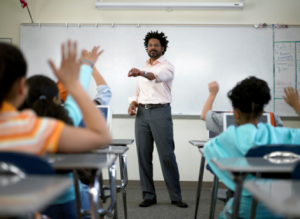(Akiit.com) A classroom needs to be a suitable learning environment, but it also has to be stimulating enough to keep kids awake. Then there’s the issue of health and safety – how far do you need to go to keep children protected? Furnishing a classroom can be a lot trickier than you might first imagine. Here are several things to consider when kitting out your schoolroom – whether you’re a kindergarten or a high school.
Safety first
When parents take their kids to school, they put their trust in teachers to keep them from harm’s way. Everything in a classroom should therefore be designed to prevent injury. Buy safe alternatives to potentially dangerous products such as solvent-free glue, safety scissors, plastic rulers and lightweight chairs.
Sharp corners on furniture will need to filed down. An alternative is to buy readily safety-proofed furniture. Some sites such as Classroom Essentials Online specialise wholly in furniture for schools and may be a good place to look.
Store items away that could potentially dangerous if left lying around. In high schools, this could include scientific equipment such as Bunsen burners, acid and chemicals. In primary schools, this could include more basic items such as scissors and staplers.
For classes of younger children, think about what dangers may be at their head height. Sinks, desks and clothes hooks should all be lowered so that they are not at kids’ head height. Big dangerous items such as guillotines, should be made inaccessible to small kids. Keeping everyone out of harm’s way should be of priority. For example, having a bleeding kit with a tourniquet in (check out the 4 types of tourniquet here), along side other safety supplies, is always a good thing.
Keep colourful
Colour is very important for children – make your classroom bright. Cover the walls in images and diagrams and use bold gender neutral colours such as reds and yellows. With plastic chairs choose a bright colour instead of black. Everyday items such as filing cabinets and chests of drawers can even be decorated.
Colour may not be as important for high school students, where too much might be seen as babyish. That said, a classroom shouldn’t be only made greys, blacks and whites. Brightly coloured walls can deeply affect the mood of a class.
Embrace the digital age
The children of today need to be computer literate so there really is no reason to cling onto a blackboard. Interactive whiteboards are taking off in schools all over the country, allowing you to plug your computer in and give presentations, as well as play interactive games with students. Interactive whiteboards also make IT lessons easier, as you can show all the class what to do and where to drag their mouse from the comfort of your desk.
Limit some digital devices though – make sure that calculators aren’t always readily available so that kids can practice mental maths. And hang up an analogue clock to encourage kids to learn how to tell the time (our reliance on digital clocks has stopped many kids from being able to tell the time the old-fashioned way).
Look and learn
Put displays up around your classroom that give facts and formulas to help kids learn. Common displays include posters that label all the organs of the body, maps of the world, periodic tables, common misspellings and lists of kings and queens. Be careful about putting up times tables as this should something kids learn by heart in order to improve mental arithmetic. Having it on a wall could cause them to cheat during a test.
Don’t surround kids with distractions. For reception classes, keep toys stored away in drawers and arts and crafts in hard to reach locations, so that when you have to sit everyone down to learn, kids will listen instead of continuously thinking about playing.
Load up on equipment
You’ll need as much paper and stationary as you can fit into your classroom. Kids will always lose and forget things such as pens, pencils and textbooks, so having a few spares is always handy. Account for items of property that are likely to get broken or damaged such as chairs and calculators – make sure you have a store cupboard somewhere in the school with a few extra chairs and tables in.
Store expensive equipment away to stop it getting damaged. Schools that have laptops often have laptop cabinets for example. Let kids know that certain items are expensive to stop them acting recklessly with them. Similarly, when kids forget or lose items, let them know that it cannot repeat, otherwise other kids will be discouraged to bring their belongings and you will always be ordering in new supplies.
Staff Writer; Larry Parker









Leave a Reply